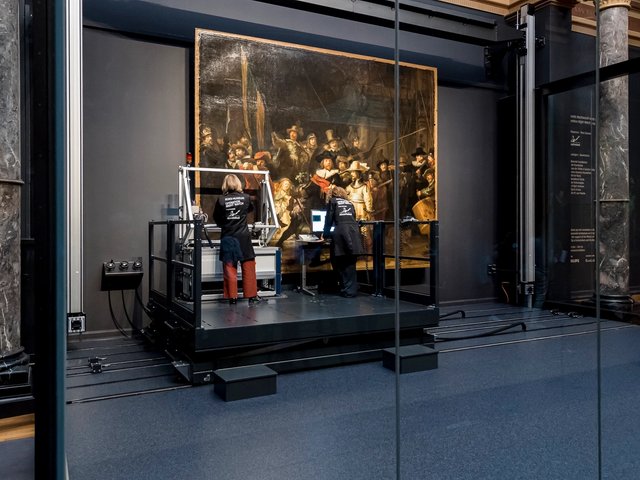In the early 2000s, conservators at Statens Museum for Kunst (SMK) in Copenhagen discovered that painted white highlights on Old Master drawings—works by Hans Holbein, Abraham Bloemaert, C.W. Eckersberg and others—were darkening at an alarming rate.
Discolouration of the lead white pigment on drawings, prints and photographs has long vexed conservators. But SMK, which holds one of the world’s largest drawings collections numbering around 18,000 works and dating back to the end of the 15th century, saw an opportunity to understand why it was happening and find ways to address it.
“When the drawings are in that condition, they cannot be exposed to the public anymore because they lose, in a way, their meaning and their appearance and so they are not suitable for display,” says Gianluca Pastorelli, a conservation scientist at SMK who is part of a multi-decade effort co-led by Niels Borring to research the degradation and find ways to protect the collection.
The challenge presented a mystery as not every work, even by a single artist in a particular time frame, exhibits discolouring. This darkening is also rarely seen in oil paintings. Of the SMK’s 800 works drawn in chalk, charcoal or pencil and painted with lead white highlights, about half experienced some degree of discolouration. An additional 200 salted prints and lithographs from Copenhagen’s Royal Library have also been affected.
Lead white was the pigment of choice for its white colour and unique qualities from antiquity onwards, until toxic health effects drove it out of fashion in the 20th century. How it has been sourced and produced has changed over time, but it was historically mixed with binders and brushed onto the works.
The researchers wondered whether certain artistic methods or materials were making the affected works more vulnerable. Pastorelli’s team used advanced, nondestructive imaging technologies, X-ray fluorescence and X-ray powder diffraction, and microsampling lead isotope analysis to essentially fingerprint the paint compounds, identify material properties and study the chemical makeup of the darkened areas.
Their research showed that changing manufacturing techniques and the chemical composition of the pigment affected vulnerability to degradation. They also found that chemical reactions were converting lead white to lead sulphide, or galena, a well known metallic-grey mineral. Micro cross sections of damaged areas revealed that it was happening most often at the surface. They deduced that the culprit was airborne sulphur-containing compounds.
Sulphur is a pollution byproduct—it comes from traffic, industry and human digestive gases—and has risen precipitously since the Industrial Revolution. At SMK, a move to temporary storage conditions was partially to blame for higher sulphur exposure levels and noticeable darkening. But why was the early 2000s such a turning point?
“We have to also remember that in 2003 to 2004, we started to have very hot summers and this has an impact on the amount of pollution that is produced from traffic or factories, and also it makes it more challenging for climate control systems inside museums and their filtering system to handle all the variables that must be limited to a certain range,” Pastorelli says. On a simple level, heat and available reactants, such as increased pollution, make chemical reactions happen faster and more readily.
“We believe lead white darkening is much less frequent on paintings largely because many paintings use oil paints, and oil indeed has a strong protective effect on lead white pigments,” Pastorelli says.
The quest for a space-age solution
Conventional treatments include using hydrogen peroxide baths or gels to lighten the darkened highlights, but carry risk of damage to the materials in the work and chemically create a new compound, which is not ideal in conservation. “It is like an old-school cancer drug—it treats, but it also destroys,” says Tomas Markevicius, an art conservator and founder of the Moxy Project research initiative.
Markevicius and his team, which includes Pastorelli, are studying an entirely new approach to this conservation challenge—the use of atomic oxygen. In May, at a conference in Perugia, he presented the first ever use of atomic oxygen to reverse lead white darkening—without water, acids or contact—on lab mockups. He calls it “a major breakthrough in both chemistry and art conservation”.
If it sounds space age, that is because it is. Atomic oxygen is a highly reactive form of oxygen found in low Earth orbit that readily interacts with chemicals around it. Nasa scientists Sharon Miller and Bruce Banks researched how this disruptive gas would impact spacecraft exteriors and later studied its use to clean items of cultural heritage.
Upon contact with atomic oxygen, organic materials like soot, stains and varnishes release into the air. “They get converted to carbon monoxide and carbon dioxide and leave as a gas, so they don’t leave residue on the surface,” Miller says.
She and Banks were able to test it out on an unlikely contaminant. At a 1997 event organised for the fashion brand Chanel at the Andy Warhol Museum in Pittsburgh, a reckless guest defaced Warhol’s hand-painted Bathtub (1961) with a lipstick-laden kiss. Conventional treatments failed to remove the makeup. Miller and Banks employed an atmospheric oxygen beam for more than five hours that removed the smudge but also some of the underlying grime and a thin paint layer.
Markevicius’s Moxy group is developing atomic oxygen technology as part of a green cluster in cultural heritage backed by the European Union to develop sustainable technologies. They aim to produce a lab-scale prototype by late 2026 and are rigorously testing mock-ups and physically sensitive materials with varying contaminants to optimise protocols.
For now, SMK is ensuring that its climate control and air-filtering systems work efficiently, but it is not taking action to lighten the darkened highlights in affected works, because there is currently no safe technique. “It’s a strong driver to develop such technologies that would have the least impact upon these incredibly valuable but also incredibly fragile structures, which are unique,” Markevicius says.





